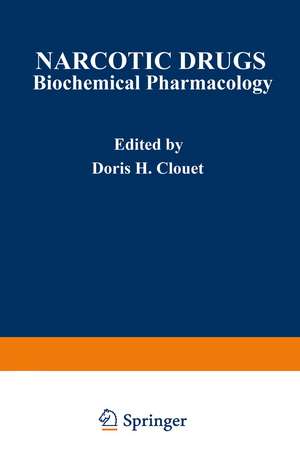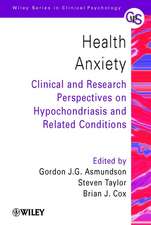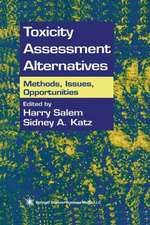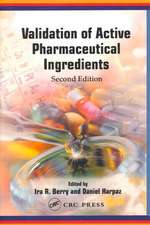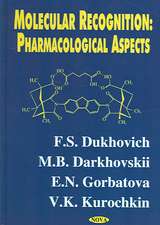Narcotic Drugs: Biochemical Pharmacology
Editat de Doris Cloueten Limba Engleză Paperback – 29 mar 2012
Preț: 1105.77 lei
Preț vechi: 1163.97 lei
-5% Nou
Puncte Express: 1659
Preț estimativ în valută:
211.58€ • 220.93$ • 174.72£
211.58€ • 220.93$ • 174.72£
Carte tipărită la comandă
Livrare economică 15-29 aprilie
Preluare comenzi: 021 569.72.76
Specificații
ISBN-13: 9781468418712
ISBN-10: 1468418718
Pagini: 532
Ilustrații: XXII, 506 p.
Dimensiuni: 152 x 229 x 28 mm
Greutate: 0.7 kg
Ediția:Softcover reprint of the original 1st ed. 1971
Editura: Springer Us
Colecția Springer
Locul publicării:New York, NY, United States
ISBN-10: 1468418718
Pagini: 532
Ilustrații: XXII, 506 p.
Dimensiuni: 152 x 229 x 28 mm
Greutate: 0.7 kg
Ediția:Softcover reprint of the original 1st ed. 1971
Editura: Springer Us
Colecția Springer
Locul publicării:New York, NY, United States
Public țintă
ResearchDescriere
The riddle of the biochemical nature of drug dependence of the opiate type has stimulated many studies directed toward understanding the molecular basis of the action of opiates, and, particularly, the phenomena of tolerance, physical dependence, and drug-seeking behavior-phenomena exhibited by man and experimental animals exposed persistently to these drugs. The results of these studies provided a substantial body of information which has been published in the scientific and medical literature. The purely pharma cological responses in man and animals to the opiates have been described and evaluated in many monographs and text-books of pharmacology. However, there is no single source for specific and detailed information on the responses of the body and its tissues to narcotic analgesic drugs at the level of biochemical pharmacology; that is, the molecular history of the drug in the body and the biochemical consequences of its presence in tissue. This volume has been prepared in an effort to repair the deficiency. Two factors have contributed a special urgency to making this infor mation available in convenient form: (1) the current need for a better under standing of the biochemical mechanisms underlying addiction to narcotic drugs, and (2) the progress made in molecular biology which promises that significant advances in the elucidation of fundamental processes in the central nervous system and their drug-induced aberrations may soon be possible.
Cuprins
I. The Chemistry of Narcotic Analgesic Drugs.- 1 The Structure of Narcotic Analgesic Drugs.- I. Introduction.- II. Morphine and Related Compounds.- III. Morphinan and Benzomorphan Derivatives.- IV. 4-Phenylpiperidines.- V. Diphenylpropylamines and Related Acyclic Analgesics.- VI. Miscellaneous Compounds.- VII. References.- 2 Methods of Chemical Analysis.- I. Introduction.- II. Solvent Extraction.- III. Qualitative Identification.- A. Chromatographic Methods.- B. Color Reactions.- C. Microcrystal Tests.- D. Physicochemical Methods.- E. Biological Methods.- IV. Quantitative Determination.- A. Photometric Methods.- B. Tracer Techniques.- C. Chromatographic Methods.- D. Polarography.- E. Titrimetric and Gravimetric Methods.- V. References.- 3 Structure-Activity Relationships.- I. Introduction.- A. Agonists, Antagonists, and Partial Agonists.- II. Morphine Analogs.- III. Morphinan Analogs.- IV. Benzomorphan Analogs.- V. Meperidine Analogs.- VI. Oripavine Derivatives.- VII. Miscellaneous.- VIII. Summary and Conclusions.- IX. References.- II. The Metabolic Disposition of Narcotic Analgesic Drugs.- 4 Physiological Disposition of Narcotic Agonists and Antagonists.- I. Introduction.- II. Dynamics of Drug Disposition.- A. Absorption.- B. Disposition.- C. Biotransformation.- D. Excretion.- III. Drug Disposition in the CNS.- A. Morphine.- B. Dihydromorphine.- C. Normorphine.- D. Heroin.- E. Codeine.- F. Meperidine.- G. Levorphanol.- H. Methadone.- I. Nalorphine.- J. Cyclazocine.- K. Pentazocine.- IV. Tolerance and Physical Dependence.- V. Summary.- VI. References.- 5 Transport in the Central Nervous System.- I. Introduction.- A. Concepts of Biological Transport.- B. Accumulation of Solutes in Cells and Tissues.- II. Transport in the Cerebrospinal Fluid System.- A. Isolated Choroid Plexus.- B. Ventriculo-Cisternal Perfusion.- III. Transport in Brain Tissue.- A. Cerebral Cortical Slices.- B. Homogenates of Brain.- C. Synaptosomes.- IV. References.- 6 Biotransformations.- I. Introduction.- II. General Patterns of Metabolism of Narcotic Drugs.- A. Chemical Reactions.- B. Effects of Species, Sex, and Dose.- C. Effects of Route of Administration.- III. Sites of Metabolism.- A. Liver.- B. Other Tissues.- IV. Metabolism of Individual Drugs.- A. d,l-a-Acetylmethadol.- B. Anileridine.- C. Codeine.- D. Cyclazocine.- E. Dextromethorphan.- F. Dihydromorphine.- G. Ethylmorphine.- H. Heroin.- I. Methadone.- J. Morphine.- K. Nalorphine.- L. Naloxone.- M. Normorphine.- N. Pentazocine.- O. d-Propoxyphene.- V. Metabolism in Tolerant Animals.- VI. References.- III. The Effects of Narcotic Analgesic Drugs on General Metabolic Systems.- 7 Intermediary and Energy Metabolism.- I. Introduction.- II. Effect of Narcotics In Vitro on Respiration and Glycolysis of Various Preparations of Brain.- III. Effect of Narcotics In Vitro on Stimulated Cerebral Cortical Slices.- IV. Effect of Morphine Administration on Cerebral Metabolism.- V. Effect of Narcotics on Certain Cerebral Enzymes In Vitro.- VI. Effect of Acute and Chronic Morphine Administration on Certain Cerebral Enzymes.- VII. Effect of Acute and Chronic Morphine Administration on Cerebral Glycolytic Intermediates.- VIII. Concluding Remarks.- IX. References.- 8 Phospholipid Metabolism.- I. Introduction.- II. Chemistry of Glycerides.- A. Neutral Glycerides.- B. Phosphoglycerides.- III. Biosynthesis of Glycerides.- A. Glyceride-Glycerol Intermediates.- B. Glycerophosphates.- C. Catabolism.- IV. Physiological Function of Glycerides.- A. Biological Membranes.- B. Active Transport.- C. Protein Synthesis.- D. Mitochondrial Function.- E. Phagocytosis.- V. Effect of Morphine and Nalorphine In Vitro and In Vivo.- A. In Vitro Studies.- B. In Vitro-In Vivo Studies.- VI. Subcellular Effect of Morphine In Vivo.- A. Brain.- B. Liver.- VII. Theoretical Considerations of Narcotic Drug Action.- A. Receptors—Phospholipids—Ions.- VIII. Summary.- IX. References.- 9 Protein and Nucleic Acid Metabolism.- I. Introduction.- II. Protein Metabolism.- A. Effects on Protein Metabolism in the Liver.- B. Effects on Protein Metabolism in Brain.- C. Amino Acids in Brain.- D. Inhibition of Protein Synthesis in Single Cells.- III. Nucleic Acid Metabolism.- A. Synthesis of RNA.- B. Synthesis of DNA.- C. Interactions of Narcotic Drugs with Nucleic Acids.- IV. Discussion.- V. References.- IV. The Effects of Narcotic Analgesic Drugs on Specific Systems.- 10 Catecholamines and 5-Hydroxytryptamine.- I. General Introduction.- II. Epinephrine.- A. Introduction.- B. Acute Effects of Morphine.- C. Effects of Chronic Morphinization.- D. Effects of Morphine Withdrawal.- E. Conclusions.- III. Norepinephrine.- A. Introduction.- B. Acute Effects of Morphine.- C. Chronic Morphinization.- D. Withdrawal of Morphine.- E. Conclusions.- IV. Dopamine.- A. Introduction.- B. Acute Effects of Morphine.- C. Chronic Effects of Morphine.- D. Effects of Morphine Withdrawal.- E. Conclusions.- V. 5-Hydroxytryptamine (5-HT, Serotonin).- A. Introduction.- B. Acute Effects of Morphine.- C. Chronic Effects of Morphine.- D. Effects of Morphine Withdrawal.- E. Conclusions.- VI. References.- 11 Acetylcholine and Cholinesterase.- I. The Effect of Morphine on Brain Acetycholine Levels.- II. The Effect of Morphine on Acetylcholinesterases.- A. In Vitro Studies.- B. In Vitro Studies.- III. The Effect of Morphine on Acetylcholine Synthesis.- IV. The Effect of Morphine on Acetylcholine Release.- V. Conclusions.- VI. References.- 12 Corticosteroid Hormones.- I. Introduction.- II. Steroid Biochemistry and Physiology.- A. Definitions and Terminology.- B. Control of Production.- III. Indexes of Adrenal Cortical Activity.- A. Adrenal Weights.- B. Circulating Eosinophil Counts.- C. Adrenal Ascorbic Acid Content.- D. Urinary and Plasma Steroids.- IV. Drug Effects.- A. Acute.- B. Chronic.- C. Abstinence.- D. Adrenal and Gonadal Responsivity.- E. Hydrocortisone Load Excretion.- F. In Vitro Steroid Synthesis.- G. Hormonal Control of Metabolism.- V. Morphine and the Adrenal Cortical Response to Various Stimuli.- VI. Summary.- VII. References.- 13 Hypothalamus: Anterior Pituitary Gland.- I. Introduction.- II. Neural Regulation of the Adenohypophysis.- III. Effects of Narcotic Analgesics on Anterior Pituitary Activity.- A. Adenocorticotropin (ACTH).- B. Thyrotropin (TSH).- C. Gonadotropins.- D. Growth Hormone (Somatotropin).- E. Prolactin.- IV. Summary and Conclusions.- V. References.- 14 Inorganic Ions: the Role of Calcium.- I. Introduction.- II. Antagonistic Effect of Calcium Ion on Morphine Analgesia.- III. Changes of Calcium Ion Level After Morphine.- IV. Calcium Concentration and the Inhibitory Effect of Morphine on the Respiration of Brain Slices In Vitro.- V. Flux of Cations Across the Cell Membrane.- VI. Lipid-Facilitated Transport of Ions.- VII. Effect of Calcium Ion on the Release of Biogenic Amines.- VIII. Effect of Calcium Ion on the Development of Tolerance.- IX. Conclusion.- X. References.- V. Sites of Action of Narcotic Analgesic Drugs.- 15 Single Cells.- I. Introduction.- II. Development of Tolerance and Physical Dependence in Tissue Culture.- III. Toxicity of Narcotics for Single Cells.- A. Mammalian Cells in Culture.- B. Microorganisms.- IV. Metabolic Studies.- A. In Bacteria.- B. In Other Systems.- V. Comments.- VI. References.- 16 The Nervous System.- I. Introduction.- II. The Isolated Spinal Cord.- A. Basic Neural Circuitry.- B. Alterations of Reflex Behavior.- C. Tolerance and Withdrawal.- III. The Decerebrated Neuraxis.- A. Cranial Nerves and Vital Centers.- B. Alterations of Lower Brainstem Functions.- C. Implications of Decerebration for Addiction.- IV. The Hypothalamus and Basal Ganglia.- A. Adaptive Processes.- B. Alterations of Subcortical Functions.- C. Implications of Decortication for Addiction.- V. The Whole Nervous System.- VI. Concluding Remarks.- VII. References.- 17 Kidney.- I. Introduction.- II. Antidiuretic Effect.- III. Development of Tolerance to the Antidiuretic Effect.- A. Explanation of Terms.- B. Studies in Rats.- C. Other Animals.- IV. Excretion of Narcotics and Metabolites in Urine.- A. Meperidine and Levorphanol Excretion and pH Dependence.- B. Morphine and Dihydromorphine Excretion.- V. References.- 18 In Peripheral Tissues.- I. The Action of Opiates on the Gastrointestinal Tract.- A. Gastrointestinal Effects of Opiates in Whole Animals.- B. Effects of Opiates in Isolated Intestinal Preparations.- II. The Action of Opiates on the Muscle of the Genitourinary Tract.- A. Urinary Tract.- B. Uterus.- III. The Effect of Opiates on the Rodent Lens.- A. The Nature of the Lens Opacity.- B. Production of Opacities in Isolated Lenses.- C. Influence of Respiratory Depression on the Production of Lens Opacities.- D. Role of Sympathetic Nervous System in the Lenticular Effect of Opiates.- E. Use of Lenticular Action of Opiates as a Model for Studying Drug-Receptor Interactions.- F. Tolerance to the Lenticular Effect of Opiates.- IV. References.- VI. Tolerance and Dependence.- 19 Tolerance and Physical Dependence.- I. The Riddle of Physical Dependence.- II. Criteria for Tolerance and Physical Dependence.- A. Tolerance.- B. Physical Dependence.- III. The Theoretical Link Between Narcotic Tolerance and Physical Dependence.- A. The Analogy to Enzyme Induction.- B. Consequences of the Induction Theory.- C. A Theory Based on Miscoding.- IV. Concluding Remarks.- V. References.- 20 Inhibitors of Tolerance Development.- I. Introduction.- II. Opioid Antagonists.- III. Effects of Biogenic Amine Depletors.- IV. Inhibitors of Protein Synthesis.- V. Other Inhibitors of Tolerance.- VI. Summary and Conclusions.- VII. References.- 21 Role of Possible Immune Mechanisms in the Development of Tolerance.- I. Introduction.- A. Theories of Tolerance.- II. Characteristics of the Development and Loss of Tolerance.- III. Possible Transferable Factors in Tolerant Animals.- A. Serum Factors.- B. Tissue Extracts.- IV. The Role of Interval and Dose in Tolerance Development.- V. The Effects of Immunosuppressors on Tolerance.- VI. Summary.- VII. References.- 22 Self-Administration Studies in Animals.- I. Introduction.- II. Techniques.- III. Suggested Biochemical Studies.- IV. References.- VII. Electrophysiological Studies in Man.- 23 Opiates and Antagonists.- I. Introduction.- II. Previous Studies.- III. Subjects and Methods.- IV. Observations.- A. Heroin.- B. Methadone.- C. Naloxone.- D. Cyclazocine.- E. Tybamate.- V. Discussion.- VI. Summary.- VII. References.- VIII. Pharmacologically Based Therapeutic Programs in Man.- 24 Opiate Antagonists in the Treatment of Heroin Dependence.- I. Introduction.- II. Cyclazocine.- A. Induction.- B. Heroin Challenge.- C. Secondary Effects.- D. Maintenance.- III. Naloxone.- A. Single Administration.- B. Chronic Oral Administration.- IV. Discussion.- V. Summary.- VI. References.- 25 Blockade with Methadone.- I. Introduction.- II. Clinical Results.- III. Pharmacology.- IV. Clinical Services.- V. Prospects for the Future.- VI. References.- 26 The Nalorphine (Pupil) Test in the Detection of Narcotic Use.- I. Introduction.- II. Measurement of Pupil Size.- III. Nalorphine Test.- IV. Naloxone Test.- V. Comparison with Urinalysis.- VI. References.
